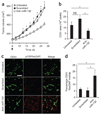MicroRNA-132-mediated loss of p120RasGAP activates the endothelium to facilitate pathological angiogenesis
- PMID: 20676106
- PMCID: PMC3094020
- DOI: 10.1038/nm.2186
MicroRNA-132-mediated loss of p120RasGAP activates the endothelium to facilitate pathological angiogenesis
Abstract
Although it is well established that tumors initiate an angiogenic switch, the molecular basis of this process remains incompletely understood. Here we show that the miRNA miR-132 acts as an angiogenic switch by targeting p120RasGAP in the endothelium and thereby inducing neovascularization. We identified miR-132 as a highly upregulated miRNA in a human embryonic stem cell model of vasculogenesis and found that miR-132 was highly expressed in the endothelium of human tumors and hemangiomas but was undetectable in normal endothelium. Ectopic expression of miR-132 in endothelial cells in vitro increased their proliferation and tube-forming capacity, whereas intraocular injection of an antagomir targeting miR-132, anti-miR-132, reduced postnatal retinal vascular development in mice. Among the top-ranking predicted targets of miR-132 was p120RasGAP, which we found to be expressed in normal but not tumor endothelium. Endothelial expression of miR-132 suppressed p120RasGAP expression and increased Ras activity, whereas a miRNA-resistant version of p120RasGAP reversed the vascular response induced by miR-132. Notably, administration of anti-miR-132 inhibited angiogenesis in wild-type mice but not in mice with an inducible deletion of Rasa1 (encoding p120RasGAP). Finally, vessel-targeted nanoparticle delivery of anti-miR-132 restored p120RasGAP expression in the tumor endothelium, suppressed angiogenesis and decreased tumor burden in an orthotopic xenograft mouse model of human breast carcinoma. We conclude that miR-132 acts as an angiogenic switch by suppressing endothelial p120RasGAP expression, leading to Ras activation and the induction of neovascularization, whereas the application of anti-miR-132 inhibits neovascularization by maintaining vessels in the resting state.
Figures




Comment in
-
Turning on the angiogenic microswitch.Nat Med. 2010 Aug;16(8):853-4. doi: 10.1038/nm0810-853. Nat Med. 2010. PMID: 20689545 No abstract available.
Similar articles
-
MicroRNA-mediated regulation of the angiogenic switch.Curr Opin Hematol. 2011 May;18(3):171-6. doi: 10.1097/MOH.0b013e328345a180. Curr Opin Hematol. 2011. PMID: 21423013 Free PMC article. Review.
-
Ras pathway inhibition prevents neovascularization by repressing endothelial cell sprouting.J Clin Invest. 2013 Nov;123(11):4900-8. doi: 10.1172/JCI70230. J Clin Invest. 2013. PMID: 24084735 Free PMC article.
-
MicroRNA-31 activates the RAS pathway and functions as an oncogenic MicroRNA in human colorectal cancer by repressing RAS p21 GTPase activating protein 1 (RASA1).J Biol Chem. 2013 Mar 29;288(13):9508-18. doi: 10.1074/jbc.M112.367763. Epub 2013 Jan 15. J Biol Chem. 2013. PMID: 23322774 Free PMC article.
-
microRNA-125b inhibits tube formation of blood vessels through translational suppression of VE-cadherin.Oncogene. 2013 Jan 24;32(4):414-21. doi: 10.1038/onc.2012.68. Epub 2012 Mar 5. Oncogene. 2013. PMID: 22391569
-
Role of RASA1 in cancer: A review and update (Review).Oncol Rep. 2020 Dec;44(6):2386-2396. doi: 10.3892/or.2020.7807. Epub 2020 Oct 13. Oncol Rep. 2020. PMID: 33125148 Free PMC article. Review.
Cited by
-
The short and long of noncoding sequences in the control of vascular cell phenotypes.Cell Mol Life Sci. 2015 Sep;72(18):3457-88. doi: 10.1007/s00018-015-1936-9. Epub 2015 May 29. Cell Mol Life Sci. 2015. PMID: 26022065 Free PMC article. Review.
-
Hypoxia-inducible MiR-182 promotes angiogenesis by targeting RASA1 in hepatocellular carcinoma.J Exp Clin Cancer Res. 2015 Jun 28;34(1):67. doi: 10.1186/s13046-015-0182-1. J Exp Clin Cancer Res. 2015. PMID: 26126858 Free PMC article.
-
C/EBP-β-activated microRNA-223 promotes tumour growth through targeting RASA1 in human colorectal cancer.Br J Cancer. 2015 Apr 28;112(9):1491-500. doi: 10.1038/bjc.2015.107. Epub 2015 Mar 31. Br J Cancer. 2015. PMID: 25867276 Free PMC article.
-
Tumor angiogenesis: putting a value on plastic GEMMs.Circ Res. 2014 Jan 3;114(1):9-11. doi: 10.1161/CIRCRESAHA.113.302812. Circ Res. 2014. PMID: 24385501 Free PMC article. No abstract available.
-
MicroRNA-132 targets HB-EGF upon IgE-mediated activation in murine and human mast cells.Cell Mol Life Sci. 2012 Mar;69(5):793-808. doi: 10.1007/s00018-011-0786-3. Epub 2011 Aug 19. Cell Mol Life Sci. 2012. PMID: 21853268 Free PMC article.
References
Publication types
MeSH terms
Substances
Grants and funding
LinkOut - more resources
Full Text Sources
Other Literature Sources
Miscellaneous

